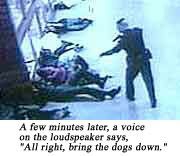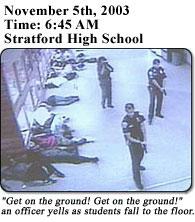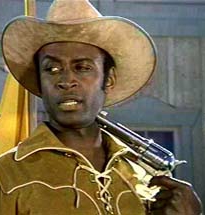
DRUG DOGS USED TO PLANT DRUGS?
Are drug dogs used to plant drugs and to frame people? Some evidence
suggests that is the case. http://rexcurry.net/drugdogsframe.html
Note that in one of the articles on the cited web page the
government's department claims that the outrageous practice is widespread
around the nation. Please alert everyone. Send info to this website of
any other jurisdictions that use such "training" methods. Also
note that the 3 gram amounts just happen to be the cutoff levels for the
stiffer trafficking charge in that jurisdiction.
For more interesting cases involving police dogs see
http://rexcurry.net/drugdogcases.html
Another case raises the question whether police
steal cocaine that is in evidence and then leave talcum powder in place
of the stolen cocaine? Some sniffer dogs were mis-trained to detect
cocaine that was borrowed from the evidence room, until someone discovered
that the "cocaine" was talcum powder.
In another case, Florida cops [*sniff*] "lost" a two-gram packet [*sniff*]
of blow used for [*sniff*] training police dogs in a hotel room.
For more information on narcotics dogs go to http://rexcurry.net/drugdogsmain.html
Police discontinue drug-training
exercise
Man incorrectly charged with
crime after cops forget narcotics placed in car to test dogs
By Frank Geary of the Las Vegas Review-Journal
Las Vegas police officers this week will end a
long-standing police dog-training practice of placing narcotics inside
the vehicles of law-abiding motorists.
For nearly 13 years, Las Vegas officers who work
with drug-sniffing dogs had placed police-confiscated narcotics in people's
vehicles to test their dogs' ability to sniff out hidden drugs.
The training exercise is common in police agencies
nationwide.
A dog is often dispatched to a traffic stop if
an officer suspects there are narcotics in a vehicle.
During a true drug search, or after a search is
completed, the canine officer would place bags of heroin, methamphetamine,
cocaine or marijuana in the vehicle as part of the staged exercise.
In response to a recent incident in which a man
was incorrectly charged with a crime, the American Civil Liberties Union
of Nevada has said the training procedure is inappropriate, and Sheriff
Bill Young said last week that the practice will be temporarily terminated.
But canine officers in Las Vegas and police-dog
experts insist the training is essential. They say stopping it could
put the department at risk if ill-equipped dogs alert on scents other
than narcotics.
"We want to expose our dogs to as many different
environments as possible," said Las Vegas canine officer Jim Seebock.
"We're asking our dogs to go find drugs in filthy conditions, so, if
we trained them in a clean environment, then we wouldn't know if they
would perform."
The officers acknowledged that not many in the
public know they routinely placed illegal drugs in the vehicles of law-abiding
citizens.
The training exercise came to light recently after
a canine officer forgot to retrieve cocaine from the vehicle of a man
who was later charged with drug possession after other investigators
found the forgotten drugs in his car.
The motorist, Mark Lilly, was arrested at the scene
after he tried to sell fake drugs to an undercover officer. His car was searched
after he had been arrested for violating a law that forbids selling fake
drugs.
With assistance from the ACLU, Lilly filed a lawsuit
against the police department earlier this month. The lawsuit claims
he was falsely charged with drug possession.
The lawsuit, which seeks damages in excess of $10,000,
also claims the arresting officers violated Lilly's constitutional rights
and that the department has a history of inadequately investigating wrongdoing
by officers.
Allen Lichtenstein, counsel for the ACLU, said
involving citizens' vehicles in dog training sets the stage for police
abuse and devastating mistakes like the one that occurred in Lilly's
case.
"It's a bad practice. It should cease immediately,"
Lichtenstein said. "A good rule of thumb is that police should not
put drugs in the cars or other property of civilians. There is a potential
for all kinds of problems, and it is unnecessary."
The lawsuit came after members of the police department's
Citizen Review Board recommended that canine officer David Newton
be suspended without pay and that other officers involved in Lilly's
arrest be terminated.
Andrea Beckman, director of the Review Board, said
last week that board members who reviewed the case are very concerned about
the training method.
"The feeling of the board is that there is a grave
concern where training exercises are being done during a live investigation,"
Beckman said. "There is the risk of a mistake. There is the problem
of Mr. Lilly potentially driving off with the Metro (police) drugs in
the back of his car."
Similar problems haven't surfaced during the past
13 years. But after the Lilly case, Young said he determined that the
dangers of the exercise outweigh its benefits.
"Because an officer failed to retrieve a training
aid, we have had two other officers accused of making a false arrest.
We have people questioning our integrity, and a lot of people question
the value, or the need, to place illegal narcotics in a vehicle when we
are dealing with a criminal suspect," Young said. "It's a matter of best
practices. Could we have avoided all of this by changing a training practice?"
The officers assigned to the canine unit's six
drug-sniffing dogs carry heroine, cocaine, methamphetamine and marijuana
with them on patrol.
Each officer carries a four-gram, 14-gram and 28-gram
bag of each drug for use in training. Each drug is kept inside a mason jar,
and all of the jars are secured inside a locker in the officer's SUV.
The 14 officers and two sergeants in the canine
unit each ride with a patrol dog, either a German shepherd or Belgian
malinois. Six of the officers also are accompanied by a drug-sniffing
canine, which are hunting breeds like Labradors, malinois and springer
spaniels.
The narcotics, which are confiscated from suspects
in drug cases, are monitored regularly by the officers' superiors and
the police crime lab, the officers said.
A supervisor weighs each officer's narcotics monthly
to make certain the weight hasn't changed, and the purity or quality
of each drug is tested by lab technicians once a year, Sgt. Jay Carlson
said.
"We do a lot to make sure our training aids are
accounted for," said Carlson, who has been with the canine unit since
1992. "There is no way I can take out my cocaine and replace it. I will
get caught."
As a result of the controversy surrounding Lilly's
arrest, police started labeling the bag as property of the department.
The notice includes the officer's name and phone number in case the training
tool is misplaced.
Lt. Kent Bitsko, who oversees the canine unit,
said the Lilly incident was a mistake and that better controls are in
place as a result, but that similar problems still could arise in the
future. Nobody is perfect, he said.
"Our controls are better now than they have ever
been, and four years from now they will be even better," Bitsko said.
"The shame of it is that it takes something bad to happen to bring it
to our attention."
Terry Fleck, deputy sheriff for the Eldorado County
sheriff's office in Northern California and a member of the United
States Police Canine Association, has trained police dogs all over
the country for years.
He said Las Vegas' canine unit is considered one
of the best.
Fleck said that training canines during traffic
stops is an essential aspect of any good police-dog program. Dogs won't
respond appropriately if they are trained, for example, to search officers'
private vehicles, cars in a junkyard or some other staged, controlled
setting.
To do their job well, the dogs must be able to
distinguish the scents of illegal narcotics from myriad odors, such
as beer cans, motor oil, perfume and groceries.
And the dogs must learn to locate drugs despite
real-life distractions, such as the noise of traffic and strangers looking
on.
"It's like night and day," Fleck said of dogs who
receive training during traffic stops and those who don't. "If he is distracted
by the cars whizzing by or the people or the McDonald's wrapper or whatever
is in the car, without the acclimation training, they are going to be distracted
just like you would be."
Bob Eden, a canine officer in Delta, British Columbia,
who founded the Eden Consulting Group, which trains police dogs for
other agencies, said dogs are smart enough to distinguish a rehearsed
training exercise from a drug search simulated under real-life circumstances.
If the dogs don't receive in-the-field training,
the dog might get lazy and become unreliable when it comes time to find
real drugs, he said.
"To get more acclimated to the real-life situation,
we want to get them out and give them as much variety as possible
so they're acclimated to real world noises, scents and distractions,"
Eden said.
"If the dog's capability is lowered due to a lack of training,
you might end up with a false indication. We want that dog to not
give a false indication, and the only way to do that is to make sure
the dog is comfortable in any environment."
|

MORE ARTICLES
ON DRUG DOGS
BELOW
http://rexcurry.net/drugdogsmain.html
http://rexcurry.net/drugdogsdan.html
http://rexcurry.net/lawdrugsoutrage.html
http://rexcurry.net/drugdogcases.html
http://rexcurry.net/drugdogmna.html
http://rexcurry.net/drugdogresume.htm
http://rexcurry.net/drugdogs2.html
http://rexcurry.net/drugdogs3.html
http://rexcurry.net/drugdogs.html
http://rexcurry.net/drugdogsb.html
http://rexcurry.net/drugdogsc.html
http://rexcurry.net/drugdogslib2.html
http://rexcurry.net/drugdogslib.html
http://rexcurry.net/drugdogsmot1.html
http://rexcurry.net/drugdogsmot2.html
http://rexcurry.net/drugdogtimes.html
http://rexcurry.net/drug-dogs-goose-creek-police-raid.html
http://rexcurry.net/drug-sense-weekly.html
http://rexcurry.net/drugs-prohibition-party-today.html
http://rexcurry.net/drugswrit.html
http://rexcurry.net/drugdogsframe.html
http://hnn.us/blogs/entries/15858.html
Playboy Magazine http://rexcurry.net/drugdog.jpg
COPS PLANT POT ? FLWeekly V 29 #
25 June 19 2004 - the attempted murder retrial Andrews 4th DCA D1328
shows the judge finds that cops intended to kill Andrews before he was
stopped, & planted pot in car.
From 2007: Documents Reveal: Cops Planted Pot
on 92-Year Old Woman They Killed in Botched Drug Raid. Atlanta resident Kathryn
Johnston's death has finally been exposed to be a case of police coverup
in clear example of the insanity of the war on drugs. http://www.alternet.org/drugs/51151/
*********************
Cops steal cocaine and leave talcum powder? Are
they looking for a thief? Maybe. Did villains get away with it? Maybe.
Should you be concerned about police?
Talcum dog team leave red faces
Padraic
Murphy
21may05
POLICE have described the substitution of talcum powder for cocaine in
the training of Victorian sniffer dogs as an "embarrassing administrative
bungle".
However, despite downplaying yesterday's revelations in The
Australian, Assistant Commissioner Paul Evans could not rule out police
corruption after confirming three separate inquiries were under way.
Mr Evans
admitted seven of the state's elite drug sniffer dogs had to be retrained
after spending more than five months on Melbourne's streets unable to
track cocaine because they were mistakenly trained to detect the drug
with talcum powder.
He said initial
investigation had indicated the talcum powder may have been mislabelled
as cocaine by police, but conceded that there may be a more sinister
explanation.
"This is an
embarrassing incident ... That's why we are having a full investigation. We
need to drill down and find out what's going on," Mr Evans said.
Police discovered
they were using talcum powder to train the dogs to detect cocaine
during an internal audit, Mr Evans said.
"The good
news is this has been picked up early by our internal processes. We
also expect to be able to quickly track down any lost babies."
Mr Evans said
police had not charged anyone with the possession of misidentified talcum
powder, but conceded it was possible the dogs had failed to detect the
presence of cocaine on suspects.
********************************
Mar. 28, 2005 from the Las Vegas Review-Journal by Vin Suprynowicz
EDITORIAL: Metro cop planted drugs in suspect's car
Sheriff says suspensions will suffice
There have long been rumors that police canine officers carry
around small quantities of contraband drugs which they can use to contaminate
a motorist's car, causing their dogs to "alert" on the vehicle and
thus justifying an otherwise illegal search of the interior and its
occupants.
Many have dismissed such stories as an urban legend.
But what would happen if a group of Las Vegas Metropolitan
police officers were actually found to have participated in such an
activity? Would all be forgiven with a wrist-slap, if they merely said
it was "a mistake"?
While officers were in the process of arresting local resident
Mark Lilly last July on suspicion of selling harmless legal substances
and claiming they were narcotics, an official police spokesman now admits,
canine officer David Newton placed real controlled drugs in Mr. Lilly's
vehicle. He has since contended he did so "as a training exercise" for
his dog.
It seems pointless to ask whether contaminating active crime
scenes is an accepted time, method, or location for a canine "training
exercise." A better question might be what Officer Newton was doing
carrying narcotics to an active crime scene in the first place. Has
he been charged with possession of those narcotics? Were they of a quantity
that would get anyone else automatically charged with "possession with
intent to sell"?
Police next expect us to believe officer Newton "forgot"
he had placed the drugs in the car, whereupon officers Kevin Collmar
and David Parker searched the car, found the planted drugs, and charged
Mr. Lilly with possession of actual controlled drugs without proper licenses
or prescriptions.
To his credit, canine officer Newton subsequently filled
out a notice to the prosecutor that he himself had possessed and planted
the drugs, and that the charge should be dropped.
But that notice somehow "never made it to the prosecutor,"
contends Las Vegas Police Deputy Chief Mike Ault, who oversees internal
investigations.
Officers Parker and Collmar then proceeded to testify against
Mr. Lilly at his preliminary hearing, failing to mention to the prosecutor
(or the court, presumably) that the possession charge should have been
dropped since the drugs had been planted by police.
Mr. Lilly was ordered to stand trial in District Court. This
generally entails considerable expense and inconvenience. Charges
were not dropped until officer Jeffrey Huyer notified the prosecution.
Internal Affairs investigators concluded Parker and Collmar
"neglected their duty" -- an awfully polite way to put it.
On Feb. 17, the often toothless Las Vegas Police Citizen
Review Board found some backbone, recommending these officers be fired
because they had filed a false report and lied in court.
But apparently those aren't firing offenses in the department
of Sheriff Bill Young. Instead, Sheriff Young said Thursday he will
suspend these two officers without pay, since the drugs were not placed
in Mr. Lilly's vehicle "intentionally."
Is the sheriff now contending the drugs fell out of officer
Newton's pocket accidentally? That he was actually planning to distribute
them at a retirement party down at the precinct house later that night?
Then what was all that hoo-hah about "conducting a training exercise"?
And -- again -- what possible legitimate purpose could a canine officer
have for carrying his own narcotics to a live crime scene?
Did we just forget to take our "dumb" pills today?
Joining in this bizarre defense of such police behavior,
Las Vegas Police Protective Association President Dave Kallas opines
"I am at least glad that the department realized the Citizen Review
Board recommendation was extreme and certainly not reasonable."
Mr. Lilly, whose car was auctioned off after it was impounded,
insists "It was no mistake. They knew what they were doing. It was
a setup."
Sheriff Young's wrist-slap punishment "raises serious questions
about the integrity of the entire criminal justice system in Southern
Nevada," says Gary Peck, executive director of the ACLU of Nevada.
That's an understatement.
How many other drug busts have officer Newton and his trained
pooch helped facilitate? How many have served time after one of these
little "training exercises"? How large a stash of contraband drugs does
the officer possess, where did he get it, and what's it for? How much
will taxpayers end up paying to settle the promised lawsuit from the
falsely accused Mr. Lilly?
Sheriff Young and his investigators apparently don't care.
Case closed.
|


 MORE DRUG DOG CASES
at http://rexcurry.net/drugdogsmain.html
MORE DRUG DOG CASES
at http://rexcurry.net/drugdogsmain.html




